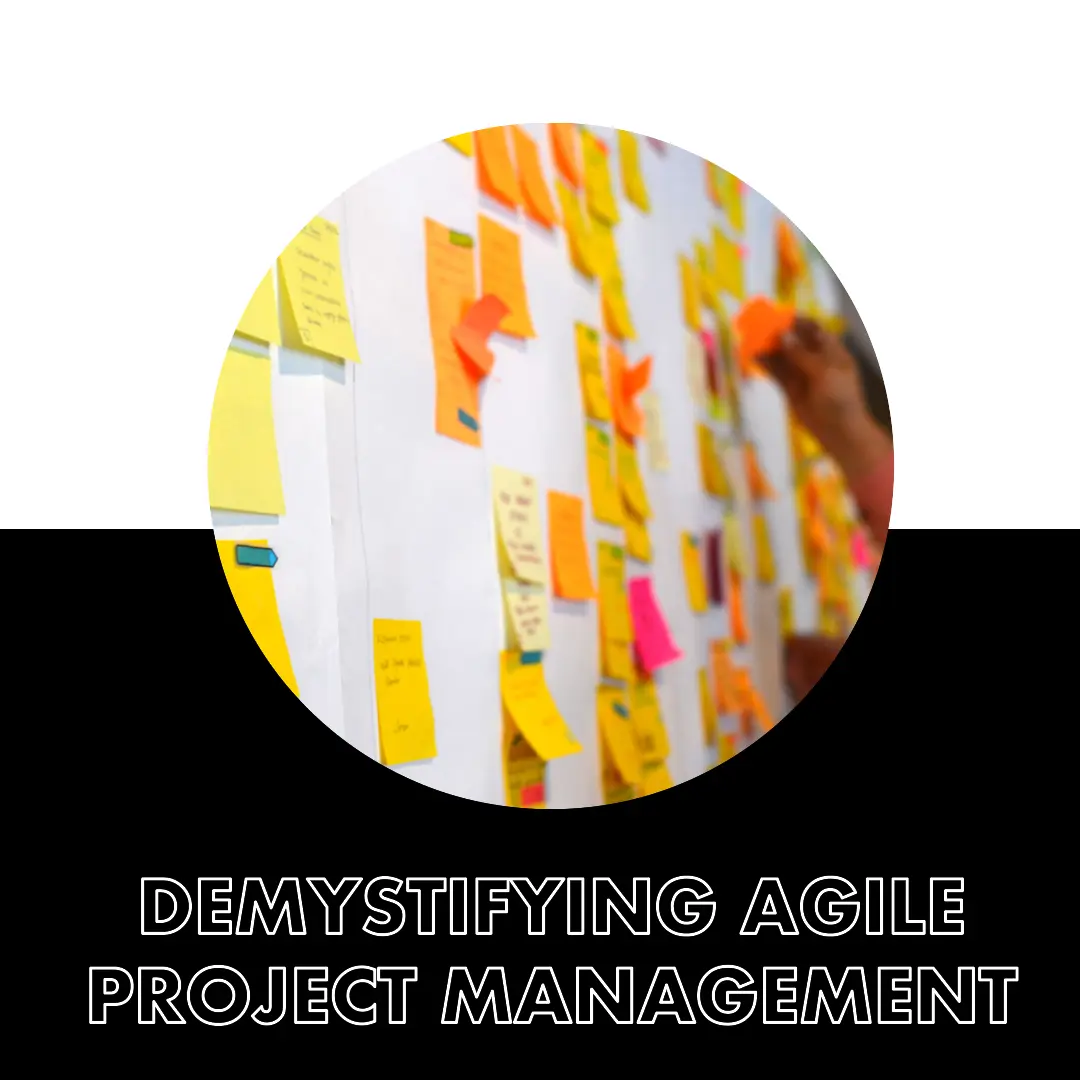I. Introduction
Hello, fellow project management enthusiasts! If you’ve stumbled upon this blog post, chances are you’ve been hearing a lot about Agile Project Management lately. In today’s fast-paced and ever-evolving business landscape, Agile has become the go-to approach for managing projects effectively. And I’m here to help you unlock the secrets behind this powerful methodology!
In this comprehensive guide, we’ll be diving deep into the world of Agile Project Management, dissecting its meaning, core principles, and what sets it apart from traditional project management methodologies like Waterfall. Whether you’re a seasoned project manager looking to sharpen your skills or a curious beginner eager to learn, this blog post is designed to provide you with valuable insights and practical knowledge to navigate the Agile landscape confidently.
So, grab a cup of coffee, buckle up, and let’s embark on this exciting journey to demystify Agile Project Management together!
II. History of Agile Project Management
Before we dive into the nitty-gritty of Agile Project Management, it’s essential to understand its roots and how it has evolved over the years. As we explore the origins of Agile, you’ll begin to see how this groundbreaking approach has revolutionized the way we manage projects in the modern business environment.
A. Origins of Agile
The story of Agile Project Management began in the early 2000s when a group of software developers came together to find a better way of managing projects. Frustrated by the rigid, bureaucratic, and often slow-moving nature of traditional project management methodologies, these innovators sought to create a more flexible and adaptive approach that could accommodate rapid changes in customer needs and technology.
Their efforts culminated in the Agile Manifesto, a groundbreaking document that laid the foundation for Agile Project Management as we know it today. With its focus on collaboration, adaptability, and delivering value to customers, Agile quickly gained traction and began to spread across various industries.
B. Evolution of Agile Methodologies
Over the years, Agile has evolved into a diverse ecosystem of methodologies and frameworks, each with its unique strengths and characteristics. From Scrum to Kanban, these approaches share the same core principles of Agile but offer different ways of implementing them.
As Agile gained popularity, it became clear that its principles could be applied beyond software development, making it a valuable approach for managing projects in various industries. Today, Agile Project Management is used by organizations worldwide, from startups to Fortune 500 companies, to drive innovation and deliver value to their customers.
C. Comparison with Traditional Project Management Methodologies
Agile Project Management stands in stark contrast to traditional project management methodologies like Waterfall. While Waterfall follows a linear, step-by-step process with little room for change, Agile embraces change and encourages iterative development and continuous improvement.
As we move forward in this guide, you’ll begin to see how Agile’s flexibility and adaptability make it an ideal fit for today’s ever-changing business landscape. By understanding the history of Agile Project Management and how it differs from traditional methodologies, you’ll be better equipped to appreciate its benefits and put its principles into practice.
Now that we’ve explored the origins and evolution of Agile Project Management, let’s delve deeper into its core principles and learn what makes it such a powerful approach to managing projects!
III. Core Principles of Agile Project Management
As we venture further into the world of Agile Project Management, it’s crucial to familiarize ourselves with its guiding principles. These principles form the foundation of Agile and serve as a compass for teams striving to create value for their customers and stakeholders.
A. Agile Manifesto
At the heart of Agile Project Management lies the Agile Manifesto, a set of four core values that emphasize collaboration, adaptability, and customer satisfaction. These values are:
- Individuals and interactions over processes and tools Agile recognizes the importance of human collaboration and communication in driving project success. While processes and tools have their place, Agile places a higher value on the relationships between team members and their ability to work together effectively.
- Working software over comprehensive documentation In the Agile world, delivering functional and valuable software to customers takes precedence over producing extensive documentation. This doesn’t mean documentation is unimportant, but Agile emphasizes the need to prioritize creating tangible value for customers above all else.
- Customer collaboration over contract negotiation Agile emphasizes building strong relationships with customers and working closely with them throughout the project. By fostering open communication and collaboration, Agile teams can better understand their customers’ needs and deliver solutions that truly meet their expectations.
- Responding to change over following a plan Agile is all about embracing change and adapting to new information as it arises. Instead of rigidly adhering to a predetermined plan, Agile teams are encouraged to be flexible and responsive, allowing them to seize new opportunities and address challenges more effectively.
B. The 12 Agile Principles
In addition to the four core values, the Agile Manifesto also lays out 12 guiding principles. These principles further refine the Agile philosophy, providing practical guidance for teams seeking to implement Agile practices. While we won’t delve into each principle in detail here, I encourage you to explore them further as they offer invaluable insights into the Agile mindset.
C. Importance of Flexibility and Adaptability in Agile
The core values and principles of Agile Project Management all point to one central theme: flexibility and adaptability are key to project success. In today’s fast-paced and ever-changing business environment, organizations must be agile (pun intended!) to stay ahead of the curve and deliver value to their customers. By embracing the core principles of Agile, teams can foster a culture of continuous improvement, innovation, and customer satisfaction.
Now that we have a solid understanding of the core principles of Agile Project Management, let’s dive into the various Agile methodologies and frameworks, and explore how each can help teams bring these principles to life.
IV. Agile Frameworks and Methodologies
With a firm grasp on the core principles of Agile Project Management, it’s time to explore the various Agile methodologies and frameworks that have emerged over the years. Each of these approaches offers a unique way to implement Agile principles, and understanding their differences can help you determine which one is best suited for your projects and team dynamics.
A. Scrum
One of the most popular Agile methodologies, Scrum, is a highly structured framework that focuses on iterative progress and collaboration. Scrum teams work in short cycles called “sprints,” typically lasting two to four weeks, with the goal of delivering a potentially shippable product increment at the end of each sprint. Scrum emphasizes transparency, inspection, and adaptation, enabling teams to continually improve and adapt to changing circumstances.
B. Kanban
Kanban is a visual workflow management method that helps teams optimize their work processes by managing work items on a Kanban board. The board’s columns represent different stages of the workflow, and work items move from left to right as they progress through the process. Kanban focuses on limiting work-in-progress (WIP), encouraging teams to complete tasks before starting new ones, and promoting a steady flow of work through the system.
C. Extreme Programming (XP)
Extreme Programming (XP) is an Agile software development methodology that emphasizes technical excellence, close collaboration, and rapid feedback loops. XP practices include continuous integration, test-driven development, and pair programming, which aim to improve software quality and responsiveness to changing customer requirements. XP encourages frequent communication between team members and customers, fostering a high level of trust and collaboration.
D. Lean Software Development
Inspired by the principles of Lean manufacturing, Lean Software Development focuses on maximizing customer value while minimizing waste. This approach emphasizes the importance of delivering high-quality software quickly and efficiently by eliminating non-value-adding activities and continually refining processes. Lean Software Development principles include optimizing the whole, building quality in, and embracing change.
E. Feature-Driven Development (FDD)
Feature-Driven Development (FDD) is an Agile methodology that concentrates on developing and delivering software features in short, iterative cycles. FDD focuses on defining and prioritizing features based on their business value and encourages close collaboration between developers, project managers, and customers to ensure alignment with customer needs.
F. Crystal
Crystal is a family of Agile methodologies that prioritize flexibility and adaptability. Each “color” in the Crystal family represents a different level of rigor and formality, with lighter colors (such as Crystal Clear) being more suitable for smaller projects and darker colors (like Crystal Orange) designed for larger, more complex endeavors. Crystal emphasizes the importance of frequent communication, reflection, and continuous improvement.
G. Dynamic Systems Development Method (DSDM)
DSDM is an Agile framework that emphasizes collaboration, flexibility, and delivering value. This approach incorporates project management best practices and provides a detailed structure for planning, executing, and controlling projects. DSDM focuses on delivering the highest business value items first and encourages active user involvement throughout the project lifecycle.
H. Comparison and Suitability for Different Projects
As you can see, there is a wide variety of Agile methodologies and frameworks to choose from, each with its unique strengths and characteristics. When selecting an approach for your projects, consider factors such as team size, project complexity, and organizational culture. Keep in mind that it’s possible to mix and match elements from different methodologies to create a hybrid approach that works best for your unique circumstances.
With a better understanding of the various Agile frameworks and methodologies, you’re well on your way to finding the perfect fit for your team. Up next, we’ll take a closer look at how Agile Project Management stacks up against the traditional Waterfall approach and explore the factors to consider when choosing a project management methodology.
V. Agile vs. Waterfall Project Management
Now that we’ve explored the diverse world of Agile methodologies and frameworks, it’s time to put them in context by comparing Agile Project Management to the traditional Waterfall approach. Understanding the key differences between these two methodologies will help you make informed decisions when choosing the best project management approach for your team.
A. Key Differences
At its core, Agile Project Management focuses on flexibility, adaptability, and collaboration, while Waterfall follows a linear, sequential process with a strict emphasis on planning and documentation. Here are some of the most significant differences between the two:
- Planning and execution: Agile encourages iterative planning and development, with teams regularly reassessing and adjusting their plans based on new information and feedback. In contrast, Waterfall relies on extensive upfront planning and follows a strict sequence of phases, with little room for change once the project is underway.
- Embracing change: Agile thrives on change, allowing teams to adapt quickly and seize new opportunities. Waterfall, on the other hand, is resistant to change, as modifications can be time-consuming and costly due to the linear nature of the process.
- Team collaboration: Agile emphasizes close collaboration between team members and stakeholders, fostering a culture of open communication and shared decision-making. Waterfall typically relies on a hierarchical structure, with distinct roles and responsibilities and limited cross-functional interaction.
- Customer involvement: Agile promotes active customer involvement throughout the project, ensuring that the final product meets customer needs and expectations. In Waterfall projects, customer feedback is generally limited to the initial requirements gathering phase and final product delivery.
B. Pros and Cons of Each Methodology
Both Agile and Waterfall methodologies have their advantages and disadvantages, and the best choice depends on the specific project and organizational context. Here’s a quick rundown of the pros and cons of each approach:
Agile Pros:
- Better adaptability to changing requirements
- Improved collaboration and communication
- Higher customer satisfaction due to frequent feedback and involvement
- Faster delivery of value through incremental releases
Agile Cons:
- Less predictable in terms of timeline and budget
- Requires a higher level of trust and discipline within the team
- May not be suitable for projects with strict regulatory requirements or heavy documentation needs
Waterfall Pros:
- Clear, well-defined project scope and timeline
- Strong emphasis on documentation and traceability
- Easier to estimate project costs and resources upfront
- Suitable for projects with strict regulatory requirements or heavy documentation needs
Waterfall Cons:
- Inflexible and resistant to change
- Limited customer involvement during the project lifecycle
- Delays in delivering value, as the entire product is delivered at the end of the project
- Higher risk of project failure due to unforeseen changes or customer dissatisfaction
C. Factors to Consider When Choosing a Project Management Approach
When deciding between Agile and Waterfall methodologies, consider factors such as the nature of the project, the team’s familiarity with Agile practices, and the level of customer involvement desired. Some questions to ask yourself might include:
- How likely is the project scope to change over time?
- How important is flexibility and adaptability for the project’s success?
- Is the team experienced with Agile practices, or open to learning and adopting them?
- How closely do you want customers and stakeholders to be involved throughout the project?
By carefully evaluating these factors, you’ll be better equipped to choose the right project.
VI. Implementing Agile Project Management
Now that you have a solid understanding of Agile Project Management and its various methodologies, you might be eager to implement it in your organization. But where do you start? In this section, we’ll walk you through the key roles and responsibilities, Agile ceremonies, tools, and techniques, as well as best practices for a successful Agile implementation.
A. Key Roles and Responsibilities
Implementing Agile Project Management successfully begins with clearly defining roles and responsibilities within your team. Some common Agile roles include:
- Product Owner: The Product Owner is responsible for defining and prioritizing the project’s requirements, ensuring that the team delivers the highest value features first. They work closely with stakeholders and customers to gather feedback and make data-driven decisions.
- Scrum Master (or Agile Coach): This role facilitates the Agile process, ensuring that the team follows Agile practices and principles. They also help remove obstacles and foster a culture of continuous improvement and collaboration.
- Development Team: The Development Team is responsible for designing, building, and testing the product. They work in close collaboration with the Product Owner and Scrum Master to ensure that the project progresses smoothly and meets customer needs.
B. Agile Ceremonies
Agile ceremonies are structured events that provide a framework for communication, planning, and review. Some of the most common Agile ceremonies include:
- Sprint Planning: During Sprint Planning, the team collaborates to decide which items from the product backlog will be worked on during the upcoming sprint and creates a plan for completing those tasks.
- Daily Stand-Up (or Daily Scrum): This short, daily meeting allows the team to share updates on their progress, discuss any obstacles they’re facing, and coordinate their efforts.
- Sprint Review: At the end of each sprint, the team demonstrates the completed work to stakeholders and gathers feedback for future improvements.
- Sprint Retrospective: This ceremony allows the team to reflect on the completed sprint, identify areas for improvement, and create a plan for implementing changes in the next sprint.
C. Tools and Techniques
There are many tools and techniques available to support Agile Project Management, ranging from physical task boards to digital project management platforms. Some popular Agile tools include Trello, Jira, and Asana, which can help teams plan and track their progress, collaborate effectively, and maintain transparency.
D. Best Practices for Agile Implementation
Successfully implementing Agile Project Management in your organization requires a commitment to continuous improvement and adaptability. Here are some best practices to keep in mind:
- Start small: Begin by implementing Agile practices in a single team or project before scaling to the entire organization. This allows you to learn and adapt as you go.
- Prioritize training and education: Ensure that all team members understand the Agile principles and practices, and invest in ongoing education and training to support their growth.
- Foster a culture of collaboration and open communication: Encourage team members to share ideas, ask questions, and provide feedback. This helps create an environment where everyone feels empowered to contribute to the project’s success.
- Embrace change and learn from failures: Agile is all about adaptability and learning from mistakes. Be open to making adjustments and iterating on your processes as needed.
By following these best practices and leveraging the knowledge you’ve gained throughout this guide, you’re well on your way to successfully implementing Agile Project Management in your organization. Good luck on your Agile journey, and remember, the key is to stay flexible, adaptive, and focused on delivering value to your customers!
VII. Conclusion
As we wrap up our comprehensive guide to Agile Project Management, it’s important to remember that adopting Agile is a journey, not a destination. The transition may present challenges, but with the right mindset, training, and commitment, your organization can reap the benefits of increased flexibility, collaboration, and customer satisfaction.
Throughout this guide, we’ve demystified the core principles of Agile, explored various methodologies and frameworks, and discussed the practical aspects of implementation. By understanding the pros and cons of Agile compared to traditional project management approaches, you’re now better equipped to make informed decisions that best suit your organization’s unique needs.
As you forge ahead, remember that the heart of Agile lies in its focus on people, collaboration, and adaptability. Embrace these principles and remain open to learning and iterating on your processes. By doing so, you’ll empower your team to thrive in an ever-changing landscape and deliver exceptional value to your customers.
Thank you for joining us on this deep dive into Agile Project Management. Here’s to your success in implementing Agile and fostering a culture of continuous improvement in your organization!
To find out how Artificial Intelligence is changing the Project Management landscape, you have enjoy reading this article https://www.shaunstoltz.com/did-artificial-intelligence-just-change-everything-about-project-management/
Find out more about Shaun Stoltz https://www.shaunstoltz.com/about/
This post was written by an AI and reviewed/edited by a human.



